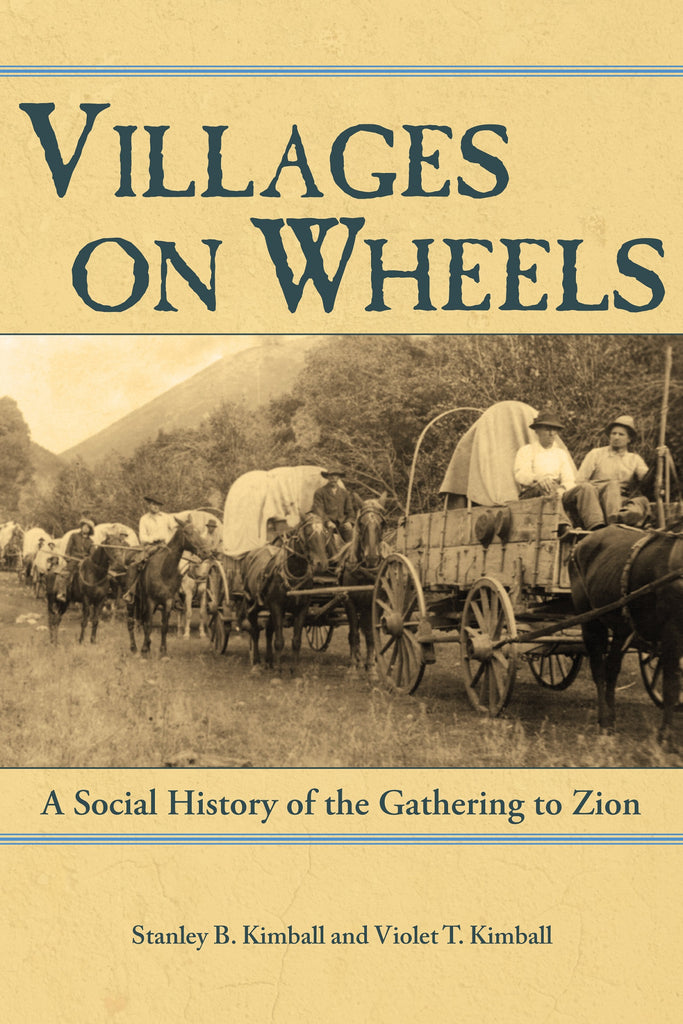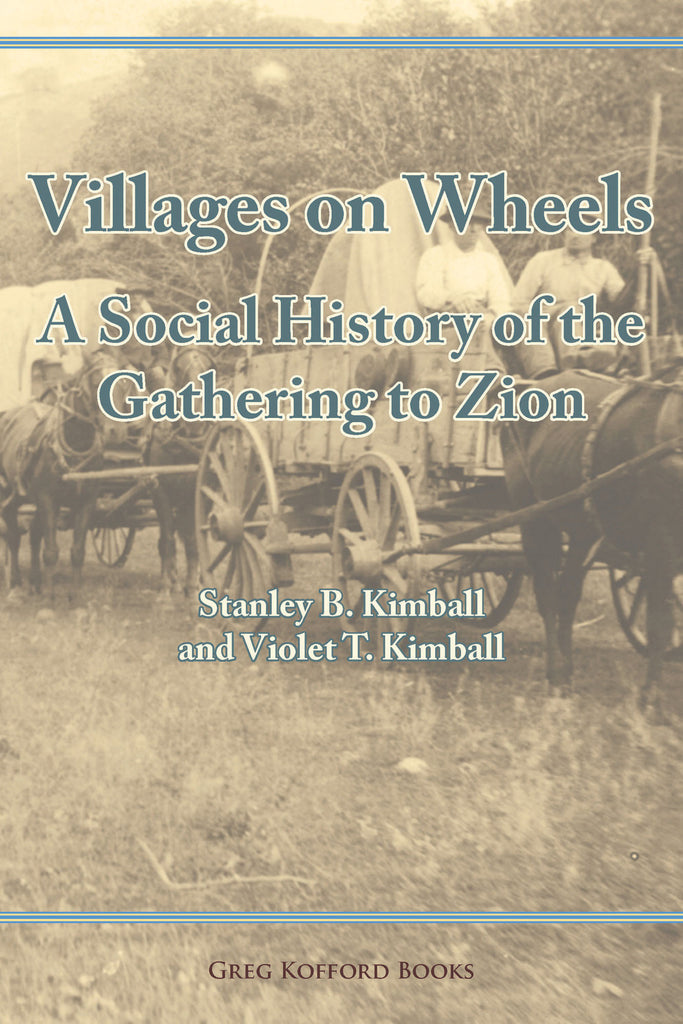Villages on Wheels: A Social History of the Gathering to Zion
$24.95
By Stanley B. Kimball and Violet Kimball
- “A riveting compilation for any reader looking to discover this monumental and defining experience in Mormon history through the accounts of the common people who lived it.” — BYU Studies Quarterly
- “There is warmth and affection for those whose stories are recounted here, as well as an honest understanding of their flaws.” — Times & Seasons
- “There is ... much to be learned from this work.” — Association for Mormon Letters



Available in ebook for Kindle, Nook, Apple, Google Play, and Kobo.
Also available through Amazon.
Book Description:
The enduring saga of Mormonism is its great trek across the plains, and understanding that trek was the life work of Stanley B. Kimball, master of Mormon trails. This final work, a collaboration he began and which was completed after his death in 2003 by his photographer-writer wife, Violet, explores that movement westward as a social history, with the Mormons moving as “villages on wheels.”
Set in the broader context of transcontinental migration to Oregon and California, the Mormon trek spanned twenty-two years, moved approximately 54,700 individuals, many of them in family groups, and left about 7,000 graves at the trailside.
Like a true social history, this fascinating account in fourteen chapters explores both the routines of the trail—cooking, cleaning, laundry, dealing with bodily functions—and the dramatic moments: encountering Indians and stampeding buffalo, giving birth, losing loved ones to death, dealing with rage and injustice, but also offering succor, kindliness, and faith. Religious observances were simultaneously an important part of creating and maintaining group cohesiveness, but working them into the fabric of the grueling day-to-day routine resulted in adaptation, including a “sliding Sabbath.” The role played by children and teens receives careful scrutiny; not only did children grow up quickly on the trail, but the gender boundaries guarding their “separate spheres” blurred under the erosion of concentrating on tasks that had to be done regardless of the age or sex of those available to do them. Unexpected attention is given to African Americans who were part of this westering experience, and Violet also gives due credit to the “four-legged heroes” who hauled the wagons westward.
Comprehensive Table of Contents:
.
Preface
Editorial Procedures
Acknowledgements
Introduction
Before the Exodus
Family/Community of Faith
Immigrants and Origins
General Health/Economic Status
The Trail Experience in Mormon History
Sources
1. The Flight from Nauvoo
Preparation and Panic
Camp Life and Routine
“To Your Tents, O Israel”
Gender Roles
Trail Communications
Clothing
Food
Trail’s End
2. Religious Life
The Word and Will of the Lord
Missionary Work and Baptisms
Sermons and Admonitions on the Trail
Shall We Begin . . .
Sabbath Observance
Prayers
Administrations
Other Miracles
Speaking in Tongues
Evil Spirits
Reaching Zion
3. Trades and Chores
Work for Goods or Cash
Music Helps Feed the Pioneers
Pausing to Farm
Trading and Barter
Teaching School
Food and Wine
Primitive Dental Work
Council Bluffs and the Overlanders
Trade on the Trail
Fort Laramie: An Oasis on the Trail
Wagons
Other Domestic Chores
4. Recreation and Social Activities
Dancing
Music and Singing
Parties and Entertainment
Educational Activities
Holidays
Painting, Drawing, Writing, and Photography
Exploring
Hunting, Fishing, and Riding
Trailside Flora and Fauna
Humor/Horseplay
Conclusion
5. Camp Rules, Obedience, and Discipline
Constitutions
Obedience
Asking God for Divine Guidance
1847–48 Companies
More Discord, More Problems
Crimes and Punishments
Discipline at Sea
Crusaders and Kind Captains
6. Young Pioneers
Getting Ready
At Winter Quarters
On the Trail
Unusual Adventures
Recreation and Toys
Parties, Pleasures, and Pranks
Handcart Children
Stragglers and Lost Children
Children’s Deaths
Pets
Summary
7. Intimate Mormon Family Life
Victorian Conventions about Bodies
Traveling Flirtations
Marriage on the Trail
Polygamy
Domestic Strife and Divorce
Childbirth
Infant and Child Care
Illness on the Trail
Summary
8. Interactions with Fellow Travelers
In 1846
Deep Suspicions
Mutual Kindness
Rescues along the Trail
The Role of Plural Marriage
Pausing in Salt Lake City
Military Encounters
Encounters during the Civil War
Encounters with Argonauts
Mail Stations, the Pony Express, and the Telegraph
Back-Trailers
9. Social Interactions with Native Americans
The Captivity Narrative
Mormon Exceptionalism
In Iowa
On the Trail
Indian Customs
Mormon Kindness
Indian Agents
Eroticism in White/Indian Relations
Indian Hostilities
10. Interactions with African Americans
During Joseph Smith’s Lifetime
On the Trail
European Converts’ Observations
Blacks in Utah
11. Disease, Accidents, Death, and Burials
Weather
Accidents with Firearms
Contamination and Infection
Funerals and Burials
Conclusion
12. The Dark Side
Oregon and California Pioneers
Selfishness and Immaturity
Physical Violence
Desperate Reactions to Suffering
Abandoned Members
Stealing
Selfishness and Harshness
Sexual Misbehavior
The Urge to Quit
Vindictiveness toward Missourians
Conclusion
13. Unsung Heros
Oxen
Cows
Horses
Mules
Mired-In Teams
Caring for Animals
Stampedes
Animal Deaths
Pets on the Trail
14. Saints by Sea
The Role of Church Agents
Aboard Ship
Separated Families
Missionaries’ Painful Partings
Going Upriver
Shipwreck
Conclusion: Miracles
Haven of Hope
Index
Praise for Villages on Wheels:
“[Villages] truly is a labor of love by non-academics for an interested lay audience. . .There is warmth and affection for those whose stories are recounted here, as well as an honest understanding of their flaws.” — Rachel Whipple, Times & Seasons
“There is, in my opinion, much to be learned from this work.” — Roy Schmidt, Association for Mormon Letters
“Villages on Wheels is a riveting compilation for any reader looking to discover this monumental and defining experience in Mormon history through the accounts of the common people who lived it.” — Haleigh Cole, BYU Studies Quarterly
About the Authors:
Violet T. Kimball and Stanley B. Kimball spent about fifteen years writing this book. Violet shared Stan’s decades-long interest in the Mormon Trail that produced numerous articles and books before his death in 2003. Violet, herself an award-winning writer and photographer, spent four summers walking and photographing the Mormon/Overland Trail along the Platte River and beyond to California and Oregon.
Violet won the 2001 Western Writer’s Spur Award and two other awards for her Stories of Young Pioneers: In Their Own Words(Missoula, Mont.: Mountain Press, 2000). Stanley won the MHA Best Book Award in 1982 for his Heber C. Kimball, Mormon Patriarch and Pioneer (Urbana: University of Illinois Press, 1981). Violet lives in Macon, Georgia, near her children and grandchildren.
More Information:
294 pages
ISBN: 9781589581197 (Paperback)
Published December 2011









Share this item: